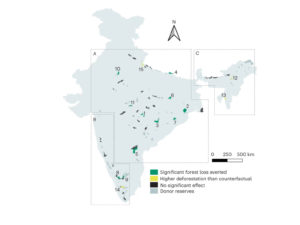By Neha Jain

New research shows that India’s tiger conservation policy has not only helped in preserving and increasing tiger populations, but it has also played a role in climate change mitigation by avoiding forest loss.
India is home to more than 70 percent of the world’s endangered tiger population. In 2005, the National Tiger Conservation Authority (NTCA) was established and key protected areas were designated as tiger reserves across India, which had enhanced protection and monitoring. By the end of 2022, around 53 tiger reserves across India were under enhanced management. Reserves under this policy are required to prepare a conservation plan regulating the extraction of forest products, reducing deforestation drivers and encouraging alternative livelihoods for communities that live within tiger conservation landscapes.
The researchers modelled forest loss and the associated carbon emissions reductions in 45 tiger reserves that were under enhanced protection from 2007 to 2020 compared with 117 untreated protected areas.
“Our study is one of the first to quantify the additional carbon benefits of a species conservation program at a large geographical scale,” says Aakash Lamba, a doctoral candidate at the National University of Singapore and lead author of the study.
Published in Nature in May 2023, the study found that between 2007 and 2020, enhanced protection within tiger reserves led to a net avoided forest loss of over 5,802 hectares — corresponding to approximately 1.08 million metric tons of carbon dioxide equivalent emissions (MtCO2e).

This translated to $93 million in ecosystem services from the avoided social cost of emissions, which is the additional damage that the Indian economy would have faced had these emissions been released into the atmosphere. This estimate corresponds to about $7 million per year between 2007 and 2020. The annual budget from Project Tiger in 2020 was $27 million. So, more than a quarter of this budget was paid back per year from the avoided social cost of emissions.
“A crucial takeaway from our findings is that biodiversity conservation can help pay for itself given the ancillary climate and consequently economic benefits arising from these programs,” Lamba points out. These findings, he says, “offer empirical evidence that conservation efforts targeted at umbrella species such as tigers can have a significant and positive ripple effect on climate change mitigation.”
“The paper shows the remarkable success of investments in Tiger Reserves in India for protecting habitat within these protected areas, as has been found in other places around the world,” says Ruth DeFries, professor of ecology and sustainable development at Columbia University, who was not connected to the study. “The investment has also benefited the national goal of carbon sequestration.
Central India versus the Northeast

The study found that 15 out of 45 tiger reserves showed significant but mixed results on deforestation. Overall, the designation of tiger reserves had a net positive impact on forest protection with 11 out of 15 reserves avoiding deforestation. Reserves in Central India showed higher avoided forest loss with Nawegaon–Nagzira Reserve emerging as the best-performing reserve. Four reserves, however, showed higher forest loss than the control models. Two of these reserves fall in Northeast India.
Deforestation in reserves in northeastern India is highly complex and averting forest loss will involve a myriad of interventions. According to Lamba, “making sure that local communities both benefit from protected areas and are key partners in the decision-making process for conservation programs is essential for equitable and effective forest conservation.”
Generating climate finance through carbon credits
According to the authors, these findings suggest that integrating species conservation programmes into global carbon markets could provide additional opportunities for funding the protection and restoration of natural habitats.
Carbon markets are well-established trading systems where carbon credits, representing a reduction or removal of greenhouse gas emissions, are bought and sold. They are issued to organizations or individuals that have taken measurable steps to reduce their carbon footprint, explains Lamba. In recent years, the voluntary carbon market has grown rapidly with nature-based climate solutions such as forest protection and restoration.

Lamba stresses that the idea of ‘additionality’ is important to understand the discussion on carbon markets. “Additionality refers to the requirement that an intervention creates additional or extra climate benefits compared to the business-as-usual scenario. Under the current definition of additionality, the avoided emissions from tiger reserves may not be eligible for the generation of carbon credits given that these reserves are already protected,” he explains.
“However, our study provides food for thought on how this idea of additionality may be expanded since we see that improvements in the management of already protected areas do in fact yield additional climate benefits. By quantifying these carbon benefits, our study shows how biodiversity conservation programs could generate revenue from carbon credits that could be traded in voluntary carbon markets. The revenue generated from the sale of these carbon credits could be reinvested back into conservation, creating a more sustainable model for financing biodiversity conservation programs.”
Limitations of the study
Ghazala Shahabuddin, visiting professor at Ashoka University, who was not part of the study, believes that tiger conservation does not represent a useful co-benefit for carbon sequestration in India’s protected area landscape.
She questions the use of remote sensing in detecting forest loss as a surrogate for biodiversity or even carbon sequestration benefits. “It is well-known that both biodiversity and carbon sequestration ability are adversely affected not only by net forest loss but also by forest degradation and conversion to monocultures. However, neither degraded forest area nor tree-based monocultures are easily detectable with the help of satellite imagery; such land uses can show up as forest of varying canopy covers,” notes Shahabuddin.

Further, Shahabuddin says that “even if we assume that remotely sensed forest cover is a good surrogate for biodiversity or carbon, the total carbon corresponding to avoided forest loss from tiger conservation is estimated only at 1.08 MtCO2e,” which, she points out, “is a very tiny fraction of the estimated annual carbon emissions in the country as of 2020 of 3.17 GtCO2e (Gigatonnes of equivalent carbon dioxide).”
Lamba acknowledges that the study focuses on deforestation, which represents the complete loss of forest cover in an area. “Forest degradation and changes in forest structure could also represent an important driver of forest carbon loss,” he explains, adding that their “estimates provide a conservative measure of carbon emissions avoided, as preventing forest degradation in these tiger reserves could result in even higher emissions reductions.”
The authors point out another caveat. “The carbon benefits discussed primarily apply to species found in high-carbon ecosystems such as terrestrial forests, limiting the generalizability of a biodiversity-first paradigm,” Lamba says. “However, since many high biodiversity areas coincide with carbon-rich protected areas, it becomes crucial to conduct such evaluations to establish an evidence base for directing more resources towards species conservation programmes.”



